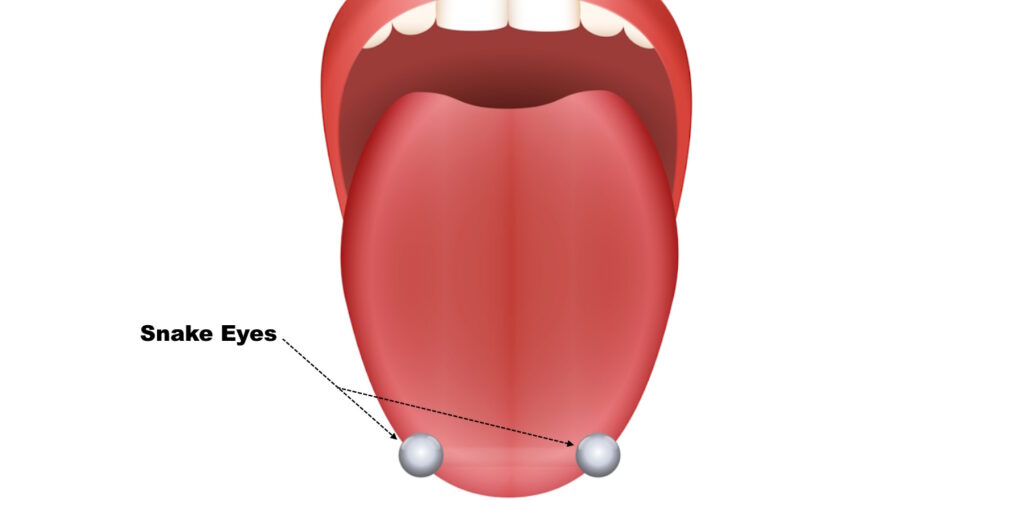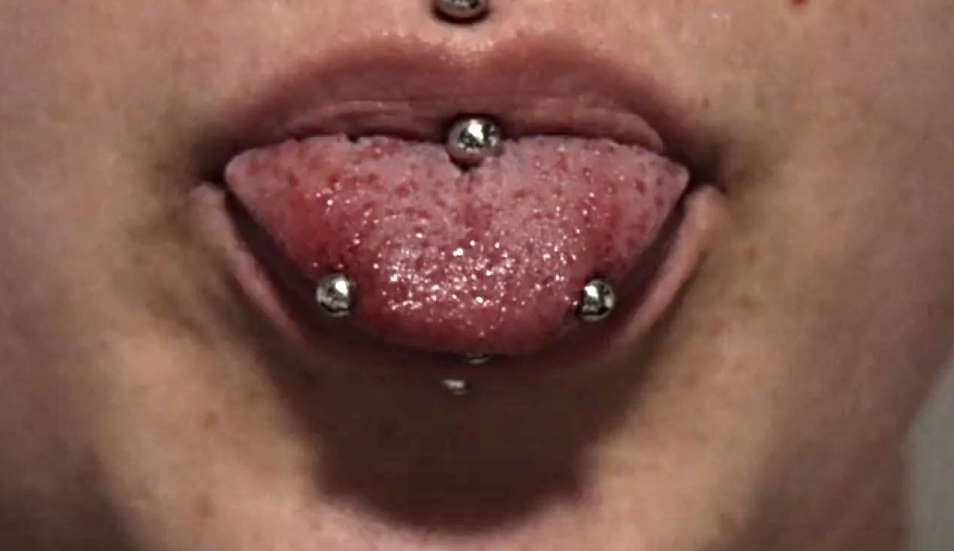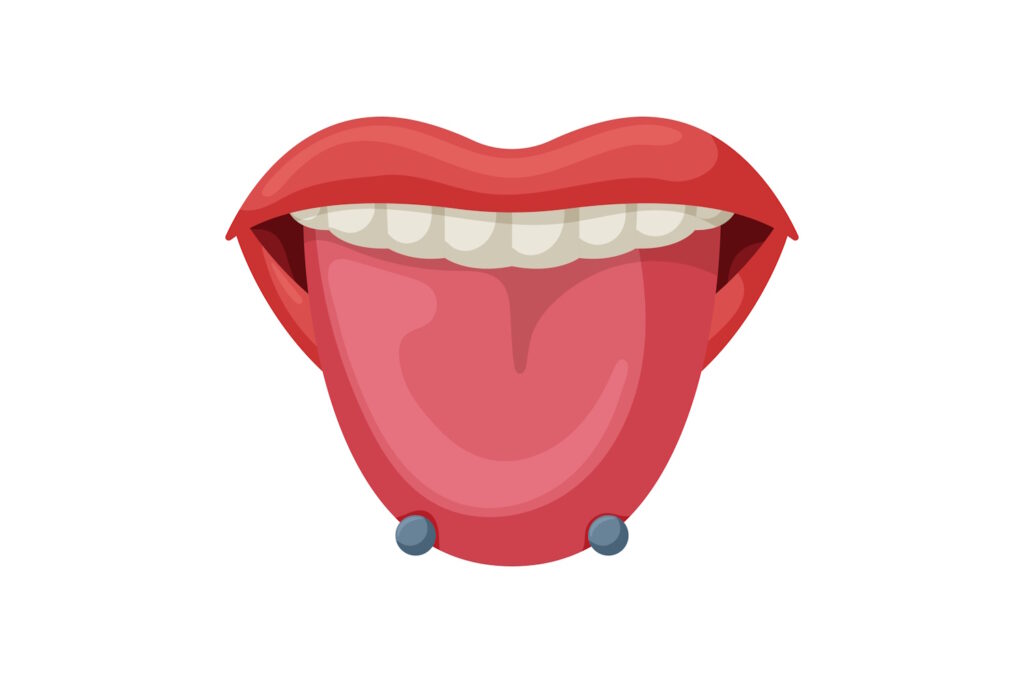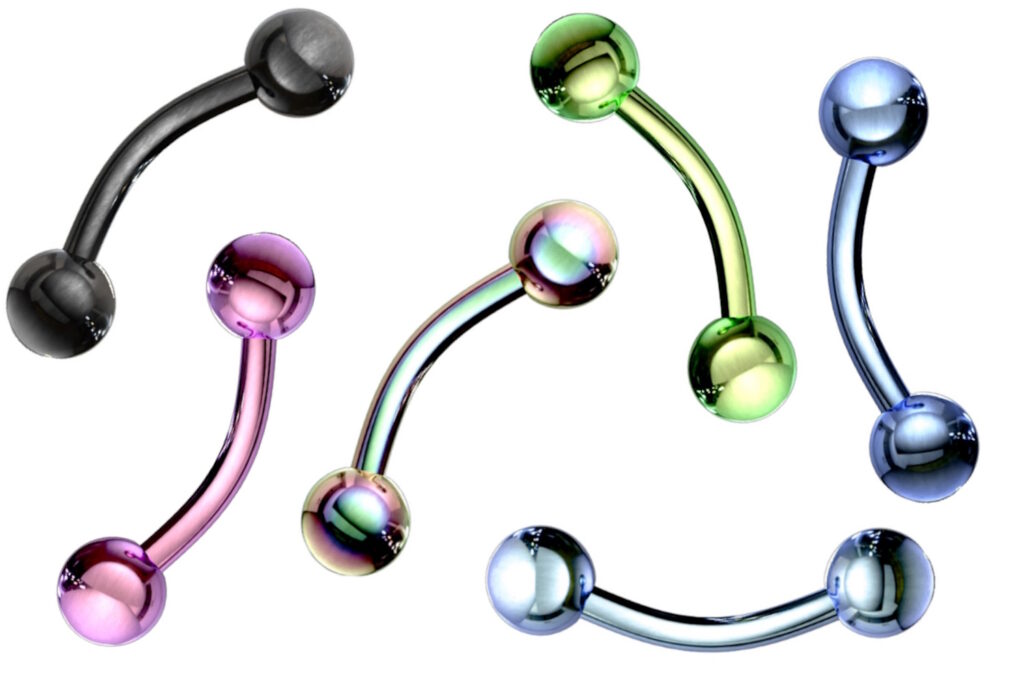
Snake Eyes Piercing: A Daring Piercing Trend Explored
Snake Eyes Piercing Article Quick Reference:
History | Myths | Complications | Pain | Cost | Procedure | Healing | Aftercare | Jewelry | Celebrities
Embarking on the path of body modification is a deeply personal endeavor, and among the myriad of options available, the snake eyes piercing stands as a unique and bold choice. This captivating modification adorns the tip of the tongue with a curved barbell, simulating a serpent’s mesmerizing gaze, and carries a rich tapestry of history that beckons exploration.
This article aims to unveil the various facets of the snake eyes piercing, shedding light on its historical roots, the nuances of the piercing procedure, and the approximate costs involved. Furthermore, we will delve into the critical phases of healing and aftercare to ensure a safe and satisfying experience.
The journey doesn’t end at the piercing studio; choosing the right jewelry is quintessential to complementing your personal style while adhering to safety standards. Join us as we navigate through the enthralling narrative of the snake eyes tongue piercing, offering a compass for those daring to explore this exotic form of self-expression. See the diagram below for the exact location of this sensational piercing.

A HISTORY OF THE SNAKE EYES
The history of the snake eyes tongue piercing, though not as ancient as other body modifications, is still deeply rooted in human culture. Body piercing practices date back to ancient civilizations in general. For instance, Ancient Egyptians adorned their bodies with various piercings, each signifying a different social or religious status. Similarly, the Aztecs, Mayans, and other indigenous tribes practiced tongue piercing, typically reserving it for religious and ritual purposes. They considered the pain and blood loss a means to communicate or connect with the gods.
In the modern era, the resurgence of body piercings, including tongue piercings, became prominent. The snake eyes piercing is a more recent development. It gained popularity in the late 1990s and early 2000s, as people sought unique and distinctive ways to express their individuality and challenge societal norms. The piercing community and industry began to experiment with various styles, placements, and techniques, leading to the creation of new and innovative piercing types.
Today, the snake eyes tongue piercing remains a popular choice for many, though it is often met with caution due to potential health risks. The placement of the piercing can lead to complications such as tooth damage, gum recession, and speech impediments.
Professional piercers often educate their clients about these risks to ensure they make informed decisions. Despite these concerns, the aesthetic appeal and statement of the snake eyes piercing still attract many individuals. Like other forms of body art and modification, it continues to be a means of self-expression, identity, and individuality in contemporary society.
SNAKE EYES PIERCING MYTHS
Snake eyes piercing myths are numerous, often stemming from misinformation or a lack of understanding about the procedure and its effects. Here are some common myths associated with this type of tongue piercing:
- Myth – It’s A Simple And Safe Procedure: One prevalent myth is that the snake eyes piercing is straightforward and without significant risks. In reality, this piercing can lead to various complications.
- Myth – Healing Is Quick And Uncomplicated: Another myth is the assumption of a quick and easy healing process. The tongue is a muscle that is constantly in motion, and with the snake eyes piercing involving the piercing of two points on the tongue connected by one piece of jewelry, healing can be complex.
- Myth – All Professional Piercers Will Perform This Piercing: Given the risks associated with snake eyes piercings, not all professional piercers are willing to perform this procedure. It requires a high level of skill and knowledge to minimize the associated risks, and many professionals advise against it due to the potential complications.
- Myth – It’s Easy to Change or Remove the Jewelry: Changing or removing the snake eyes piercing jewelry can be challenging due to swelling and the healing process. It’s not as easily interchangeable as other types of piercings, and a professional should ideally perform removal to avoid complications.
It’s essential for individuals considering a snake eyes piercing to be well-informed and aware of the potential risks and complications. Consulting with a professional piercer and seeking advice is the best path to take so you know more than just the myths.
SNAKE EYES PIERCING POPULARITY
Different factors, including gender and age, can widely vary the popularity of the snake eyes piercing. However, it’s important to note that individual preferences for body modifications like piercings are highly personal and resist easy generalization.
Here’s a general overview based on recent trends:
- Based On Gender: Snake eyes piercings have been popular among some men, particularly those who are fans of alternative or edgy styles. In the context of masculinity, some men opt for this piercing as a form of self-expression, aligning with a rugged or rebellious aesthetic.
Women also get snake eyes piercings, often as a unique and bold statement of individuality. For some women, this piercing can be a form of self-empowerment, a way to take ownership of their bodies and express their personal style. - Based On Age Groups: Teenagers and young adults typically show more adventurousness and willingness to experiment with different forms of self-expression, including various types of body piercings. Young adults, particularly those aged 18 to 30, often favor the snake eyes piercing for its distinctive and bold appearance.
While not as common in the middle age group, some of these adults who are fans of body modification might opt for a snake eyes piercing. It can be a way to express individuality or even experience a form of mid-life reinvention.
Remember, these general observations and trends do not dictate individual choices about body piercings, which are highly personal and varied. Individuals should consider the snake eyes piercing carefully due to its potential health risks and seek professional advice before proceeding. Always seek a qualified professional to perform any piercing in a sterile environment, minimizing the risk of complications.
THE RISKS
While the snake eyes piercing can be an appealing aesthetic choice for some, there are several associated risks and potential complications:
- Infection: A snake eyes piercing can become infected if not properly cared for, leading to swelling, pain, and potentially more severe health issues.
- Speech Impediment: The placement of the piercing can interfere with normal tongue mobility, potentially leading to slurred or impeded speech.
- Tooth Damage: The metal barbell can chip or crack the teeth when it comes into contact with them. It can also lead to the wearing down of the enamel over time.
- Gum Recession: Constant contact between the metal jewelry and the gums can cause the gums to recede, leading to sensitivity and other oral health issues.
- Swelling And Breathing Difficulties: The tongue may swell significantly after the piercing, potentially leading to breathing difficulties in extreme cases.
- Migration And Rejection: The body might treat the jewelry as a foreign object and attempt to push it out, leading to migration or rejection.
- Nerve Damage: Though rare, there’s a risk of nerve damage during the piercing process, which can affect tongue movement and sensation.
- Difficulty Eating: The piercing can interfere with normal eating habits, making it uncomfortable or challenging to move food around the mouth or chew properly.
- Prolonged Healing Time: The tongue is a muscle that’s constantly in motion, which can lead to a prolonged and uncomfortable healing process.
- Salivary Gland Damage: There’s a risk of damaging the salivary glands, which can lead to complications like dry mouth or excessive drooling.
Given these risks, it’s essential for anyone considering a snake eyes piercing to consult with a professional piercer who can provide personalized advice based on the individual’s health, anatomy, and other factors.

THE COMPLICATIONS
Not only should you take these risks into consideration, but you also want to take any of your current health conditions into consideration before getting a snake eyes tongue piercing. Consider these below:
- Oral Health Issues: A tongue piercing can exacerbate existing oral health issues and may interfere with things like braces.
- Blood Disorders: If you have a condition that affects blood clotting, a piercing can lead to excessive bleeding. Also, being anemic can affect your body’s ability to heal from the piercing.
- Autoimmune Diseases: Conditions like lupus, rheumatoid arthritis, and others can affect the healing process and increase the risk of infection.
- Diabetes: Diabetes, especially when not well-controlled, can slow down the healing process and increase the risk of infection.
- Heart Conditions: Certain heart conditions can increase the risk of endocarditis, an inflammation of the heart’s inner lining.
- Hepatitis And Other Infectious Diseases: If you have an infectious disease, especially those affecting the liver, it’s crucial to consider the added risk.
- Medications: Blood thinners can lead to excessive bleeding during and after the piercing. Also, immunosuppressants can affect the body’s ability to heal and fight off infections.
- Pregnancy: Pregnant women should be cautious as an infection can potentially impact the fetus.
- Alcohol And Tobacco Use: Both can affect the body’s ability to heal. Smoking, in particular, can increase the risk of oral health issues.
- Nutritional Deficiencies: Adequate nutrition is essential for healing; deficiencies can slow down the process.
Before deciding to get a snake eyes piercing or any other body modification, it’s advisable to consult with a professional. This is especially true if you have underlying health conditions. They can provide personalized advice based on your health status and history.
WHAT SHOULD I DO IF I NO LONGER WANT MY SNAKE EYES PIERCING?
If you decide that you no longer want your snake eyes piercing, it’s advisable to consult a professional. Professionals can guide safely removing the jewelry and caring for the piercing site afterward.
If you choose to remove the jewelry at home, ensure that your hands and tools are clean. Continue cleaning the piercing site with non-alcoholic, saline solutions and avoid unnecessary agitation to the area to promote healing.
Maintain a high level of oral hygiene and avoid irritants like spicy foods, alcohol, and tobacco. Monitor the area for signs of infection, such as excessive redness, swelling, or discharge, and seek medical attention if necessary.
Allow ample time for the hole to close up, being patient with the healing process. Eating a balanced diet and staying hydrated can support your immune system and facilitate healing. Be prepared for an adjustment period. If there’s residual scarring, seeking professional advice on management or reduction is recommended.
SNAKE EYES PIERCING PAIN
A snake eyes piercing can be quite painful. The level of pain varies from person to person. With that said, many individuals describe it as one of the more painful piercings due to the sensitivity and density of nerve endings in the tongue. Pain during the piercing process is typically brief but intense.
To alleviate the pain and discomfort associated with a snake eyes piercing:
- Use Pain Relief Medication: Over-the-counter pain relievers like ibuprofen or acetaminophen can help reduce pain and swelling. Make sure to follow the recommended dosage instructions.
- Ice: Applying ice to the area can help numb the pain and reduce swelling. Use a clean cloth or an ice pack wrapped in a cloth and apply it for short intervals.
- Follow Aftercare Instructions: Proper aftercare is crucial for healing and minimizing discomfort.
It’s important to consult with a professional piercer for proper guidance on aftercare and pain management. Additionally, if you experience severe pain, prolonged swelling, or signs of infection (such as pus, increased redness, or fever), seek immediate medical attention.
WHAT IS THE COST OF A SNAKE EYES PIERCING?
The cost of a snake eyes tongue piercing can vary widely. Some factors that influence the price include location, piercing studio reputation, piercer experience, and the type of jewelry selected. Below is a general cost range for the snake eyes piercing in different regions of the U.S. Please be aware that actual prices may fluctuate based on the specific studio and other circumstances.
- East Coast: (e.g., New York City, NY; Boston, MA; Miami, FL; Washington, DC)
- Low End: $50 – $70
- High End: $90 – $130
- South: (e.g., Atlanta, GA; Dallas, TX; Nashville, TN; New Orleans, LA)
- Low End: $45 – $65
- High End: $80 – $120
- West Coast: (e.g., Los Angeles, CA; San Francisco, CA; Seattle, WA; San Diego, CA)
- Low End: $60 – $80
- High End: $100 – $150
- Midwest: (e.g., Chicago, IL; Detroit, MI; Minneapolis, MN; St. Louis, MO)
- Low End: $40 – $60
- High End: $70 – $110
While cost is a consideration, prioritize the studio’s cleanliness, the piercer’s expertise, and the quality of the jewelry. Paying a bit more for a reputable piercer in a hygienic environment can help prevent complications and additional expenses. Always consult with local studios for up-to-date pricing information.

GET READY FOR THE SNAKE EYES PIERCING PROCEDURE
A snake eyes piercing requires precision and care during the procedure to ensure a successful and safe piercing. Here are the steps involved in a snake eyes piercing:
- Consultation: Before the actual piercing, you’ll have a consultation with a professional piercer. You’ll have the opportunity to ask questions, discuss the piercing process, and select the appropriate jewelry. The piercer will also assess your tongue’s suitability for the piercing.
- Preparation: The piercer will begin by washing their hands thoroughly. Then they will put on fresh disposable gloves to maintain a sterile environment.
- Sterilization: Next, the piercing equipment, including the needle, forceps, and jewelry, will be sterilized. This is done by using an autoclave or other medical-grade sterilization method.
- Marking: The piercer will mark the entry and exit points for the piercing on the tip of your tongue.
- Numbing: Some piercers may offer a topical numbing gel or anesthetic spray to minimize discomfort during the piercing.
- Piercing: With the marked points in place, the piercer will use a single hollow needle to pierce through the tongue horizontally. The needle should go through swiftly and smoothly. This will reduce trauma to the tissue. The jewelry will be immediately inserted through the fresh piercing.
- Securing the Jewelry: Once the jewelry is in place, the piercer will securely fasten the ends. That ensures they are tight and properly aligned to avoid any issues with biting or irritation.
- Aftercare Instructions: Your piercer will provide you with detailed aftercare instructions. They will also answer any questions that you may have about aftercare and healing.
- Follow-Up: Most piercers recommend a follow-up appointment to check the healing progress.
It’s crucial to choose an experienced and reputable piercer for a snake eyes piercing. This will ensure that the procedure is done safely and with minimal risk of complications.
SNAKE EYES HEALING TIME
The healing time for a snake eyes piercing varies depending on several factors. These factors include your overall health, oral hygiene, and aftercare practices. Generally, it takes anywhere from 4 to 8 weeks for the initial healing process. However, complete healing can sometimes take several months.
During the healing period, it’s important to follow proper aftercare instructions to prevent infections and ensure a smooth healing process. It’s important to note that snake eyes piercings can carry a higher risk of complications. It can also lead to issues with tooth and gum health. Regular check-ups during the healing process can also help in addressing any issues that might arise early on.
AFTERCARE FOR THE SNAKE EYES PIERCING
A snake eyes piercing requires careful aftercare to promote healing and prevent infections. Here are the general aftercare steps:
- Oral Hygiene: Rinse your mouth with an alcohol-free, antimicrobial or saline mouthwash after every meal and before bed. This helps to keep the piercing clean and free from bacteria.
- Avoid Certain Foods And Drinks: Stick to soft, non-spicy foods to minimize discomfort. Avoid alcohol, spicy, salty, and acidic foods and drinks as they can irritate the piercing. Stay away from hot beverages as they can cause swelling.
- Ice And Cold Water: Gently suck on ice or drink cold water to reduce swelling. This is especially helpful in the first few days after piercing.
- No Smoking Or Alcohol: Avoid smoking and alcohol consumption as they can hinder the healing process.
- Good Oral Habits: Avoid playing with the jewelry as this can cause trauma to the piercing. Keep your tongue movements to a minimum in the initial healing period.
- Maintain General Oral Health: Continue brushing your teeth twice daily, but be gentle around the piercing site.
- Regular Cleaning: Clean the piercing with saline solution or sea salt soak. Mix 1/4 teaspoon of non-iodized sea salt with 1 cup of warm bottled water.
- Check The Jewelry: Make sure the jewelry is secure but avoid unnecessary touching or twisting.
- Watch For Infection: Look out for signs of infection, such as excessive swelling, pain, foul odor, or discharge. Consult a healthcare professional if any of these symptoms arise.
- Regular Check-ups: Visit your piercer for regular check-ups and to ensure the piercing is healing correctly.
Remember, healing times can vary from person to person. Always follow the advice given by your professional piercer. Consult with them if you encounter any issues during the healing process.
CHANGING THE STARTER JEWELRY
Changing the starter jewelry for a snake eyes piercing should be done cautiously. Typically you should not change the jewelry until the piercing has fully healed. Here are some guidelines and tips:
When to Change:
- Healing Period: A snake eyes piercing generally takes about 4 to 8 weeks to heal, but this can vary. It’s crucial to wait until it’s completely healed before attempting to change the jewelry.
- Consult Your Piercer: Before changing your jewelry for the first time, it’s recommended to consult with your professional piercer. They can assess if your piercing is ready for a change and can offer advice or assistance.
Tips for Changing Jewelry:
- Clean Hands: Always wash your hands thoroughly with antibacterial soap before handling your piercing or jewelry.
- Sanitize New Jewelry: Ensure that the new jewelry is properly sterilized. This can be done by boiling it in water or using a piercing solution.
- Be Gentle: Don’t force it out; if it feels stuck or painful, stop and seek advice from a piercer.
- Use Lubrication: Applying a small amount of water-based lubricant to the jewelry can make the insertion process smoother.
- Avoid Irritants: Don’t use alcohol or hydrogen peroxide to clean the new jewelry. These can be too harsh on the healing tissue.
- Follow Aftercare: After changing the jewelry, continue with regular aftercare practices to prevent infection or irritation.
- Seek Help If Needed: If you’re struggling or feel uncomfortable changing the jewelry, have it done professionally by a piercer.
It’s important to note that snake eyes piercings carry a higher risk than other tongue piercings. This is due to their location and the potential impact on the tongue’s mobility and oral health. Regular check-ups with your piercer and dentist are advisable.
GOOD JEWELRY MATERIALS
For snake eyes piercings, choosing the right jewelry material is crucial to minimize the risk of allergic reactions, infections, and other complications. Here are some of the recommended materials:
- Implant-Grade Stainless Steel: Often referred to as surgical stainless steel. Implant-grade stainless steel boasts hypoallergenic properties, perfect for initial piercings.
- Titanium: Particularly implant-grade titanium (ASTM F136 or F67) is highly recommended for its biocompatibility, lightweight nature, and resistance to body fluid corrosion. It’s an excellent choice for people with nickel allergies.
- 14K Or Higher Gold: If choosing gold, ensure it’s solid (not plated) and at least 14K. Higher karats of gold are softer and less likely to contain irritants but may be more susceptible to scratching and wear.
- PTFE / Bioplast: These flexible materials are sometimes recommended for oral piercings due to their softness, which can be less damaging to teeth and gums. However, they may not be suitable for initial piercings and should be used only after the piercing has fully healed.
It’s crucial to avoid materials like nickel, costume jewelry, and plated metals, especially for initial piercings, as they can cause allergic reactions or other complications.

THE BEST TYPES OF JEWELRY
The most appropriate style of body jewelry for a snake eyes piercing is typically a small, curved barbell. Here are some key points to consider regarding the jewelry style for this piercing:
- Curved Barbell Type: A curved barbell is the standard choice. It’s important that the barbell is the correct length to accommodate swelling but not so long that it causes discomfort or damage to teeth and gums.
- Gauge Size: The typical gauge size for a snake eyes piercing ranges from 14 to 16 gauge. Your piercer will choose the best size for your anatomy.
- Ball Ends: The curved barbell usually has small, rounded ends (balls) to prevent the jewelry from causing damage inside the mouth. These ends should be smooth and securely attached to the barbell.
- Length and Fit: Initially, a slightly longer barbell may be used to accommodate for swelling. Once healed, it’s advisable to switch to a shorter barbell to reduce the risk of damage to teeth and gums.
- Avoiding Certain Styles: Jewelry with sharp edges, dangling parts, or large decorative elements are not recommended for snake eyes piercings due to the risk of oral damage and interference with tongue movement.
It’s important to follow the advice of your professional piercer when choosing jewelry, especially for a specialized piercing like snake eyes. They can provide guidance on the best style and fit for your individual anatomy and healing process.
SNAKE EYES AND CELEBRITIES
Unfortunately, there are no widely known celebrities with snake eyes piercings, more than likely because piercing is somewhat controversial and less common than other types of body piercings.
Celebrity piercing choices often gain attention, but the snake eyes piercing hasn’t been a popular or publicly acknowledged choice among high-profile individuals. It’s worth noting that celebrities’ style choices, including piercings, can change frequently, so it’s always possible that a celebrity may choose to get this type of piercing in the future.
For the latest information on celebrity piercings or trends, I would recommend checking current entertainment news sources or social media updates.
ENDING THOUGHTS
The snake eyes piercing, an intriguing and distinct style within the body modification community, captures attention for its bold and unconventional appearance.
It’s crucial to acknowledge the risks associated with snake eyes piercings. Dental health concerns, such as damage to teeth and gums, are significant considerations. There’s also the potential for speech impediments and difficulties in eating. These factors make it essential for anyone considering this piercing to consult with a professional, experienced piercer who can provide personalized advice and assess suitability.
While the snake eyes piercing can be a unique and expressive form of body art, it requires careful consideration, a clear understanding of the risks involved, and a commitment to aftercare. As with any body modification, it’s a personal decision that should be made with full awareness and responsibility. For those who decide to proceed, finding a reputable professional piercer and adhering to their guidance is key to ensuring the best possible experience with your snake eyes piercing.
Need to find a piercer? Check out the Association of Professional Piercers.
Author: Scott S.
